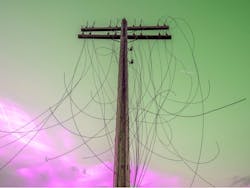Australian Utility Replacing Overhead Network with Microgrids
RenewEconomy’s Giles Parkinson describes a plan by Horizon Power to pull down power lines and replace them with renewable stand-alone power systems (SAPS), aka microgrids.
Horizon Power is to become the first utility in Australia to remove parts of its overhead network and replace it with an off-grid renewable energy power solution.
The West Australia (WA) government announced on Thursday that the state-owned Horizon, which serves the vast regional areas of the state, will now install 17 standalone power systems (microgrids) on fringe-of-grid properties east of Esperance, and cut down 40 miles of network wiring that was prone to outages.
The move by Horizon, flagged earlier this year, has been expanded from the original target of 13 customers and 34 miles of poles and wires removed from the grid, and the first stand alone system has now been installed.
Other networks in WA and the eastern states are expected to follow suit, once a long awaited rule change is finalized by the Australian Energy Market Commission that will clear the regulatory hurdles that prevented networks from making what is an increasingly obvious decision on the basis of economics, reliability and emissions.
Solar plus storage driving change
WA energy minister Bill Johnston on Thursday visited a farming property in Neridup, east of Esperance, to view one of Horizon Power’s new standalone power systems, which enable customers to generate and store their own electricity, without connecting to the overhead electricity network.
The property he visited has a 10.8 kW solar array, 25 kWh of battery storage, and a back-up diesel generator.
“With its own solar panels, batteries, inverters and back-up diesel generator, a standalone power system can supply power 24/7, regardless of the weather, and is more reliable and safe,” the minister said in a prepared statement.
The poles and wires in the area, he noted, were prone to outages caused by weather events, wildlife, farm machinery, accidents and bushfires.
“The energy sector is undergoing a significant transformation, which is mainly driven by the rapid uptake of solar panels and battery storage systems at homes,” Johnston said.
The network operator in the state’s main grid, Western Power, also wants to take some 56 customers off the grid and provide them with renewables-based stand alone power systems, although that effort does not result in the same loss of infrastructure.
However, Western Power has identified some 15,000 customers that it could take off-grid, and remove hundreds if not thousands of miles of costly poles and wires, and its actions prompted the AEMC to change the rules.
“This is as close to a ‘no brainer’ as we can get.”
Two years ago, Western Power argued that it could save $400 million through such a scheme. Essential Energy in NSW says it costs up to $25,000 per customer, per year, to clear vegetation in some areas, and it also notes that one 1,184 miles of line serves just 335 customers.
The costs of serving regional customers are among the biggest cross-subsidies in the electricity sector, and taking thousands of customers off grid and replacing the poles and wires with solar and batteries will reduce costs and likely lower bills.
“This is as close to a ‘no brainer’ as we can get,” said Andrew Dillon, the CEO of Energy Networks Australia, which teamed up with the Alternative Energy Association and the Public Interest Advocacy Center to urge the regulators to come to the party.
Horizon Power’s CEO Stephanie Unwin said the stand alone systems will significantly improve reliability for customers by removing long rural lines which can experience frequent and prolonged power outages.
“Standalone power is a viable alternative in remote locations where poles and wires are prone to outages caused by lightning strikes, bush fires, vegetation and bird strikes,” Unwin said.
“Over the last three years we have successfully demonstrated technologies, such as SPS, which improves reliability of power supply and safety for our customers and can offer sustainable energy solutions at a lower cost than traditional solutions.”
Horizon leading with stand-alone power systems
Horizon expects to have installed the 17 SAPS units for customers living in the Neridup and Beaumont farming areas in the Goldfields-Esperance region by the end of the year, saying it’s “leading the energy market transformation as the first utility to replace traditional infrastructure with an alternative, renewable energy power solution that is fully off the grid.”
You can see a video here.
Johnston in his statement also pointed to the broader transition in the state, various important reviews that are being conducted to provide a blueprint for the uptake of renewables, and to co-ordinate the uptake of rooftop solar, battery storage and electric vehicles in the state’s main grid.
“Improving our energy sector in Western Australia is essential and overdue, which is why the McGowan Government launched its Energy Transformation Strategy earlier this year,” he said. “The government is looking at a range of options and initiatives to evolve the state’s power system and deliver a cleaner, brighter and more resilient energy supply for decades to come.”
This blog originated on RenewEconomy and was reposted with permission. Author Giles Parkinson is the pubication’s founder and editor.
